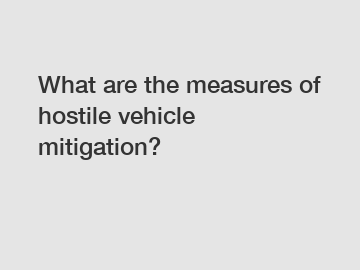What are the measures of hostile vehicle mitigation?
In today's uncertain world, the security landscape demands continuous innovation and enhanced protective measures. While physical barriers and security practices have long been in place to combat potential threats, one area that has gained significant attention in recent times is hostile vehicle mitigation. Ensuring the safety of public spaces and infrastructure from vehicular attacks necessitates a comprehensive understanding of the measures employed to counteract such threats. In this blog, we will delve into the subject of hostile vehicle mitigation, exploring the various strategies and technologies deployed to safeguard against potential harm.
1. Understanding the Need for Hostile Vehicle Mitigation.
The rise in vehicular attacks worldwide has amplified the urgency to develop effective solutions, placing public safety at the forefront. Acts of terrorism and deliberate actions aimed at causing mass casualties have underscored the importance of comprehensive hostile vehicle mitigation plans. Whether it be bustling city centers, crowded tourist destinations, or critical infrastructure sites, the need to secure these spaces has never been more crucial.

2. Selecting Appropriate Physical Barriers.
Physical barriers serve as the frontline defense against hostile vehicles. While their primary function is to impede unauthorized or harmful vehicles, it is essential to strike a balance between functionality, aesthetics, and ease of integration. Options such as bollards, planters, retractable barriers, and reinforced fences are employed to prevent vehicle intrusion while maintaining the overall architectural and urban design integrity.
3. Integrating Intelligent Surveillance Systems.
Advancements in surveillance technology continue to bolster hostile vehicle mitigation strategies. Monitoring solutions utilizing artificial intelligence, video analytics, and high-resolution cameras offer a proactive approach to identifying potential threats. Intelligent surveillance systems can detect irregular vehicle movements, unauthorized entry attempts, and even assess driver behavior to trigger appropriate response protocols swiftly.
4. Utilizing Active Vehicle Mitigation Systems.
Beyond passive physical barriers, active vehicle mitigation systems provide an additional layer of security. Innovations such as active bollards, crash-rated gates, and retractable barriers offer the capacity to automatically respond to potential vehicular threats. These systems can swiftly deploy countermeasures to obstruct, divert, or immobilize hostile vehicles before substantial damage can occur.
5. Effective Traffic Planning and Management.
Efficient traffic planning and management play a pivotal role in mitigating hostile vehicle threats. Analyzing traffic patterns, creating safe traffic flows, and assessing vulnerable areas can help identify potential target zones and develop adequate defensive strategies. Collaborating with transportation experts and employing technology-driven approaches, such as intelligent traffic signal systems, enables prompt reaction and minimizes response times.
6. Public Education and Awareness.
Empowering the public through comprehensive education and awareness campaigns is paramount in fostering a safer environment. Reinforcing the importance of reporting suspicious activities, stressing the significance of adhering to traffic regulations, and instilling a culture of vigilance can significantly contribute to thwarting potential threats. By encouraging citizens to be active stakeholders in their own safety, we strengthen the collective drive towards a secure society.
Conclusion.
Hostile vehicle mitigation encompasses a range of measures aimed at protecting public spaces and infrastructure from vehicular threats. By combining physical barriers, intelligent surveillance systems, active vehicle mitigation technologies, effective traffic planning, and public engagement, a comprehensive defense strategy can be established. Given the evolving nature of threats, continually improving and adapting these measures is essential to ensure the safety and security of our communities. As we forge ahead, sustained collaboration between security professionals, architects, urban planners, and citizens will be vital to anticipate, prevent, and counteract potential vehicular attacks effectively. Let us unite in our commitment to creating a world where public safety is prioritized and hostile vehicle threats are decisively mitigated.
For more information, please visit road blockers, ZASP, Hydraulic Automatic Bollards.
95
0
0


Comments
All Comments (0)